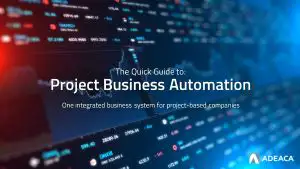Many companies lack the proper tools to efficiently evaluate estimate at completion (EAC), which is the most critical component of the financial month-end process for project-driven companies.
Oftentimes, they end up only detecting variances once actual cost exceeds the total project budget. By that time, it’s too late to implement mitigating measures. Finding out about additional costs after the fact is no way to run a successful business.
The problem is companies spend lots of time and resources manually consolidating data from multiple systems into a spreadsheet to calculate EAC which becomes a tedious task. In addition to the ERP, companies operate in other point solutions to fill their needs gap. This is why many companies don’t bother to calculate EAC or do it so infrequently that it doesn’t help them actively manage their projects with it.
How to Calculate EAC
EAC is the current expectation of total cost at the end of a project. It represents the final project cost given any additional costs incurred to date and the expected costs to complete the project.
While there are many ways to calculate EAC, the most common method is a “bottoms-up” formula. This means the actual costs (AC) are added to the forecasted remaining spend, or the estimate to complete (aka cost to complete).
In addition, EAC can be manually and automatically adjusted. Manual adjustments are often done by the controller in the costing sheet and automatic adjustments to EAC are based on posted actual costs and recorded committed costs.
Calculating EAC with Adeaca Project Business Automation
In a completely integrated and comprehensive system like Adeaca Project Business Automation, EAC adjustments can be based on completed quantities and remaining work estimates from the work breakdown structure.
However, to effectively manage EAC, it’s important to break down the project budget into manageable pieces, which is done in the cost breakdown structure (CBS). The CBS enables you to isolate budget positions making it possible to re-estimate the project with confidence and making sure any budget overruns are identified.
Adeaca PBA provides the CBS, something that is often missing in most project business systems today. The fact of the matter is, many project business solutions today use the WBS to manage both the operational and financial aspects of a project which is problematic because it poses a major project governance flaw.
EAC in Adeaca PBA is adjusted daily or weekly. At the end of every month, the full EAC dataset is compiled and stored for future reference and trend analysis. This supports project-driven companies that are shifting towards a data-driven culture. In Adeaca PBA, the CBS and the full EAC process are completely embedded in the ERP application. The integrated nature of PBA provides the foundation for a data-driven organization by enabling real-time information and analysis.
This makes it a lot easier to manage because there’s no reliance on manual data integration, mapping, or consolidation. All costing data is available on demand since you have access to real-time data with a full audit trail.
To learn more about Project Business Automation, download the PBA Quick Guide.











